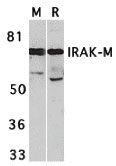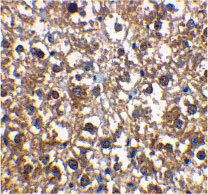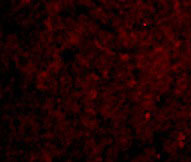IRAK-M Antibody
- SPECIFICATION
- CITATIONS
- PROTOCOLS
- BACKGROUND

Application
| WB, IHC-P, IF, E |
|---|---|
| Primary Accession | Q9Y616 |
| Other Accession | NP_009130, 5225377 |
| Reactivity | Human, Mouse, Rat |
| Host | Rabbit |
| Clonality | Polyclonal |
| Isotype | IgG |
| Calculated MW | Predicted: 66 kDa Observed: 70 kDa |
| Application Notes | IRAK-M antibody can be used for detection of IRAK-M by Western blot at 1 µg/mL. IRAK-M antibody can also detect IRAK-M by immunohistochemistry at 2 µg/mL. For immunofluorescence start at 10 µg/mL. |
| Gene ID | 11213 |
|---|---|
| Other Names | IRAK-M Antibody: ASRT5, IRAKM, Interleukin-1 receptor-associated kinase 3, IL-1 receptor-associated kinase M, IRAK-3, interleukin-1 receptor-associated kinase 3 |
| Target/Specificity | IRAK3; IRAK-M antibody is predicted to have no cross reactivity to other members of the IRAK family. |
| Reconstitution & Storage | IRAK-M antibody can be stored at 4℃ for three months and -20℃, stable for up to one year. As with all antibodies care should be taken to avoid repeated freeze thaw cycles. Antibodies should not be exposed to prolonged high temperatures. |
| Precautions | IRAK-M Antibody is for research use only and not for use in diagnostic or therapeutic procedures. |
| Name | IRAK3 {ECO:0000312|EMBL:AAH57800.1} |
|---|---|
| Function | Putative inactive protein kinase which regulates signaling downstream of immune receptors including IL1R and Toll-like receptors (PubMed:10383454, PubMed:29686383). Inhibits dissociation of IRAK1 and IRAK4 from the Toll-like receptor signaling complex by either inhibiting the phosphorylation of IRAK1 and IRAK4 or stabilizing the receptor complex (By similarity). Upon IL33-induced lung inflammation, positively regulates expression of IL6, CSF3, CXCL2 and CCL5 mRNAs in dendritic cells (PubMed:29686383). |
| Cellular Location | Cytoplasm. Nucleus. Note=In dendritic cells, translocates into the nucleus upon IL33 stimulation. {ECO:0000250|UniProtKB:Q8K4B2} |
| Tissue Location | Expressed in eosinophils, dendritic cells and/or monocytes (at protein level) (PubMed:29686383). Expressed predominantly in peripheral blood lymphocytes (PubMed:10383454) |

Thousands of laboratories across the world have published research that depended on the performance of antibodies from Abcepta to advance their research. Check out links to articles that cite our products in major peer-reviewed journals, organized by research category.
info@abcepta.com, and receive a free "I Love Antibodies" mug.
Provided below are standard protocols that you may find useful for product applications.
Background
IRAK-M Antibody: Interleukin-1 (IL-1) and lipopolysaccharide (LPS) induces cellular response through IL-1 receptor (IL-1R) and Toll like receptors (TLR). IL-1 receptor-associated kinase (IRAK and IRAK2) mediates the activation of NF-betaB by IL-1/Toll receptors, which is a pivotal transcription factor mediating inflammatory and immune response. A novel member in the IRAK/Pelle family was recently identified and designated IRAK-M. IRAKs associate with IL-1/Toll receptors after IL-1 or LPS stimulation and the dominant negative mutants of IRAKs inhibit IL-1 or LPS induced NF-betaB activation. Members in IRAK/Pelle family play a central role in IL-1R/TLR mediated inflammatory responses to cytokine IL-1 and LPS.
References
Cao Z, Henzel WJ, and Gao X. IRAK: a kinase associated with the interleukin-1 receptor. Science 1996; 271:1128-31.
Muzio M, Ni J, Feng P, et al. IRAK (Pelle) family member IRAK-2 and MyD88 as proximal mediators of IL-1 signaling. Science 1997; 278:1612-5.
Wesche H, Gao X, Li X, et al. IRAK-M is a novel member of the Pelle/interleukin-1 receptor-associated kinase (IRAK) family. J. Biol. Chem. 1999; 274:19403-10.
If you have used an Abcepta product and would like to share how it has performed, please click on the "Submit Review" button and provide the requested information. Our staff will examine and post your review and contact you if needed.
If you have any additional inquiries please email technical services at tech@abcepta.com.













 Foundational characteristics of cancer include proliferation, angiogenesis, migration, evasion of apoptosis, and cellular immortality. Find key markers for these cellular processes and antibodies to detect them.
Foundational characteristics of cancer include proliferation, angiogenesis, migration, evasion of apoptosis, and cellular immortality. Find key markers for these cellular processes and antibodies to detect them. The SUMOplot™ Analysis Program predicts and scores sumoylation sites in your protein. SUMOylation is a post-translational modification involved in various cellular processes, such as nuclear-cytosolic transport, transcriptional regulation, apoptosis, protein stability, response to stress, and progression through the cell cycle.
The SUMOplot™ Analysis Program predicts and scores sumoylation sites in your protein. SUMOylation is a post-translational modification involved in various cellular processes, such as nuclear-cytosolic transport, transcriptional regulation, apoptosis, protein stability, response to stress, and progression through the cell cycle. The Autophagy Receptor Motif Plotter predicts and scores autophagy receptor binding sites in your protein. Identifying proteins connected to this pathway is critical to understanding the role of autophagy in physiological as well as pathological processes such as development, differentiation, neurodegenerative diseases, stress, infection, and cancer.
The Autophagy Receptor Motif Plotter predicts and scores autophagy receptor binding sites in your protein. Identifying proteins connected to this pathway is critical to understanding the role of autophagy in physiological as well as pathological processes such as development, differentiation, neurodegenerative diseases, stress, infection, and cancer.




